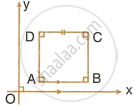Advertisements
Advertisements
प्रश्न
The side AB of a square ABCD is parallel to the x-axis. Find the slopes of all its sides. Also, find:
- the slope of the diagonal AC.
- the slope of the diagonal BD.

उत्तर
We know that the slope of any line parallel to x-axis is 0.
Therefore, slope of AB = 0
As CD || BC, slope of CD = Slope of AB = 0
As BC ⊥ AB, slope of BC = `-1/"slope of AB"` = `(-1)/0` = not defined
As AD ⊥ AB, slope of AD = `-1/"slope of AB"` = `(-1)/0` = not defined
i. The diagonal AC makes an angle of 45° with the positive direction of x-axis.
∴ Slope of AC = tan 45° = 1
ii. The diagonal BD makes an angle of – 45° with the positive direction of x-axis.
∴ Slope of BD = tan (– 45°) = −1
APPEARS IN
संबंधित प्रश्न
Without using the distance formula, show that the points A(4, −2), B(−4, 4) and C(10, 6) are the vertices of a right-angled triangle.
Find the slope and the inclination of the line AB if : A = (−3, −2) and B = (1, 2)
Find the value of p if the lines, whose equations are 2x – y + 5 = 0 and px + 3y = 4 are perpendicular to each other.
Find the value of k for which the lines kx – 5y + 4 = 0 and 5x – 2y + 5 = 0 are perpendicular to each other.
Angle made by the line with the positive direction of X-axis is given. Find the slope of the line.
45°
Find the slope of a line passing through the given pair of points (9,-2) and (-5,5)
Find the value of a line perpendicular to the given line 5x+2y-9 = 0
Find the slope and the y-intercept of the following line 5x - 2y = 6
Find the slope and the y-intercept of the following line 3x + y = 7
Find the slope and the y-intercept of the following line 2x + 3y = 12
